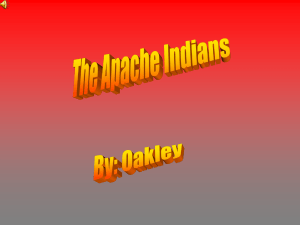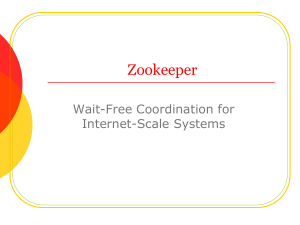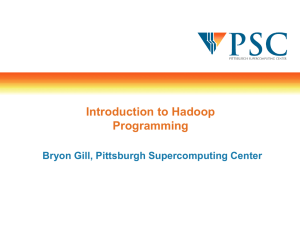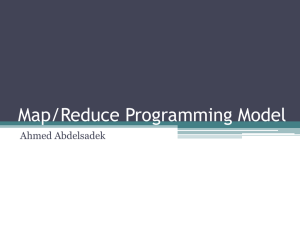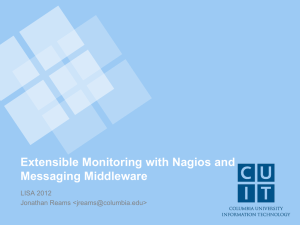PPT - Big Data Open Source Software and Projects
advertisement
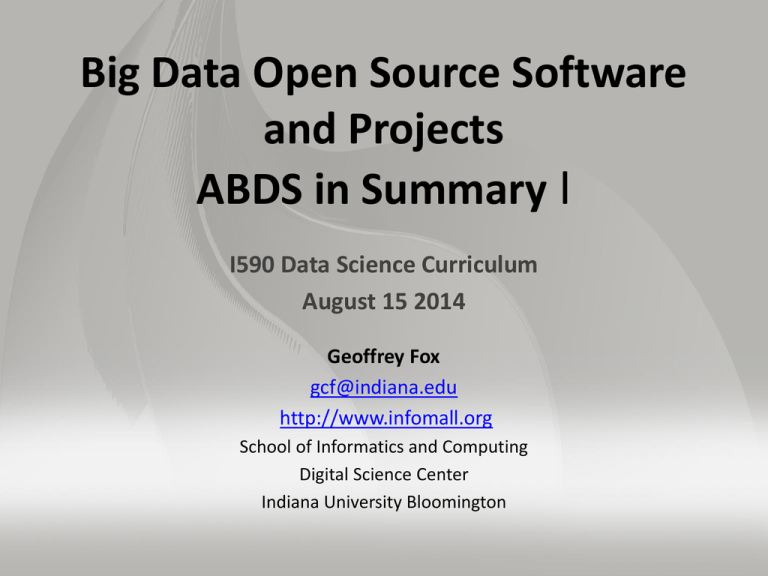
Big Data Open Source Software and Projects ABDS in Summary I I590 Data Science Curriculum August 15 2014 Geoffrey Fox gcf@indiana.edu http://www.infomall.org School of Informatics and Computing Digital Science Center Indiana University Bloomington Kaleidoscope of (Apache) Big Data Stack (ABDS) and HPC Technologies October 10 2014 Cross-Cutting Functionalities 1) Message and Data Protocols: Avro, Thrift, Protobuf 2)Distributed Coordination: Zookeeper, Giraffe, JGroups 3)Security & Privacy: InCommon, OpenStack Keystone, LDAP, Sentry 4)Monitoring: Ambari, Ganglia, Nagios, Inca 17 layers ~200 Software Packages 17)Workflow-Orchestration: Oozie, ODE, ActiveBPEL, Airavata, OODT (Tools), Pegasus, Kepler, Swift, Taverna, Triana, Trident, BioKepler, Galaxy, IPython, Dryad, Naiad, Tez, Google FlumeJava, Crunch, Cascading, Scalding, e-Science Central, 16)Application and Analytics: Mahout , MLlib , MLbase, DataFu, mlpy, scikit-learn, CompLearn, Caffe, R, Bioconductor, ImageJ, pbdR, Scalapack, PetSc, Azure Machine Learning, Google Prediction API, Google Translation API 15)High level Programming: Kite, Hive, HCatalog, Tajo, Pig, Phoenix, Shark, MRQL, Impala, Presto, Sawzall, Drill, Google BigQuery (Dremel), Google Cloud DataFlow, Summingbird 14A)Basic Programming model and runtime, SPMD, Streaming, MapReduce: Hadoop, Spark, Twister, Stratosphere, Reef, Hama, Giraph, Pregel, Pegasus 14B)Streaming: Storm, S4, Samza, Google MillWheel, Amazon Kinesis 13)Inter process communication Collectives, point-to-point, publish-subscribe: Harp, MPI, Netty, ZeroMQ, ActiveMQ, RabbitMQ, QPid, Kafka, Kestrel, JMS, AMQP, Stomp, MQTT Public Cloud: Amazon SNS, Google Pub Sub, Azure Queues 12)In-memory databases/caches: Gora (general object from NoSQL), Memcached, Redis (key value), Hazelcast, Ehcache 12)Object-relational mapping: Hibernate, OpenJPA, EclipseLink, DataNucleus and ODBC/JDBC 12)Extraction Tools: UIMA, Tika 11C)SQL: Oracle, DB2, SQL Server, SQLite, MySQL, PostgreSQL, SciDB, Apache Derby, Google Cloud SQL, Azure SQL, Amazon RDS 11B)NoSQL: HBase, Accumulo, Cassandra, Solandra, MongoDB, CouchDB, Lucene, Solr, Berkeley DB, Riak, Voldemort. Neo4J, Yarcdata, Jena, Sesame, AllegroGraph, RYA, Espresso Public Cloud: Azure Table, Amazon Dynamo, Google DataStore 11A)File management: iRODS, NetCDF, CDF, HDF, OPeNDAP, FITS, RCFile, ORC, Parquet 10)Data Transport: BitTorrent, HTTP, FTP, SSH, Globus Online (GridFTP), Flume, Sqoop 9)Cluster Resource Management: Mesos, Yarn, Helix, Llama, Celery, HTCondor, SGE, OpenPBS, Moab, Slurm, Torque, Google Omega, Facebook Corona 8)File systems: HDFS, Swift, Cinder, Ceph, FUSE, Gluster, Lustre, GPFS, GFFS Public Cloud: Amazon S3, Azure Blob, Google Cloud Storage 7)Interoperability: Whirr, JClouds, OCCI, CDMI, Libcloud,, TOSCA, Libvirt 6)DevOps: Docker, Puppet, Chef, Ansible, Boto, Cobbler, Xcat, Razor, CloudMesh, Heat, Juju, Foreman, Rocks 5)IaaS Management from HPC to hypervisors: Xen, KVM, Hyper-V, VirtualBox, OpenVZ, LXC, Linux-Vserver, VMware ESXi, vSphere, OpenStack, OpenNebula, Eucalyptus, Nimbus, CloudStack, VMware vCloud, Amazon, Azure, Google and other public Clouds, Networking: Google Cloud DNS, Amazon Route 53 1) 2) 3) 4) 5) 6) 7) 8) 9) 10) 11) 12) 13) 14) 15) 16) 17) HPC-ABDS Layers Message and Data Protocols Distributed Coordination: Security & Privacy: Monitoring: IaaS Management from HPC to hypervisors: DevOps: Interoperability: Here are 17 functionalities. Technologies are File systems: presented in this order Cluster Resource Management: 4 Cross cutting at top Data Transport: 13 in order of layered diagram starting at SQL / NoSQL / File management: bottom In-memory databases&caches / Object-relational mapping / Extraction Tools Inter process communication Collectives, point-to-point, publish-subscribe Basic Programming model and runtime, SPMD, Streaming, MapReduce, MPI: High level Programming: Application and Analytics: Workflow-Orchestration: 1) 2) 3) 4) 5) 6) 7) 8) 9) 10) 11) 12) 13) 14) 15) 16) 17) HPC-ABDS Layers Message and Data Protocols Distributed Coordination: Security & Privacy: Monitoring: IaaS Management from HPC to hypervisors: DevOps: Interoperability: Here are 17 functionalities. Technologies are File systems: presented in this order Cluster Resource Management: 4 Cross cutting at top Data Transport: 13 in order of layered diagram starting at SQL / NoSQL / File management: bottom In-memory databases&caches / Object-relational mapping / Extraction Tools Inter process communication Collectives, point-to-point, publish-subscribe Basic Programming model and runtime, SPMD, Streaming, MapReduce, MPI: High level Programming: Application and Analytics: Workflow-Orchestration: Apache Thrift • http://en.wikipedia.org/wiki/Apache_Thrift • Thrift is an interface definition language and binary communication protocol that is used to define and create services for numerous languages. • It is used as a remote procedure call (RPC) framework and was developed at Facebook for "scalable cross-language services development". • It combines a software stack with a code generation engine to build services that work efficiently to a varying degree and seamlessly between C#, C++ (on POSIX-compliant systems), Cappuccino, Cocoa, Delphi, Erlang, Go, Haskell, Java, Node.js, OCaml, Perl, PHP, Python, Ruby and Smalltalk • Note this type of capability augmented by serializers such as Java Kyro Google Protobuf (Protocol Buffers) • http://en.wikipedia.org/wiki/Protocol_Buffers • Protocol Buffers are a way of encoding structured data in an efficient yet extensible format. Google uses Protocol Buffers for almost all of its internal RPC protocols and file formats. • Protocol Buffers are a method of serializing structured data. As such, they are useful in developing programs to communicate with each other over a wire or for storing data. The method involves an interface description language that describes the structure of some data and a program that generates from that description source code in various programming languages for generating or parsing a stream of bytes that represents the structured data. • Protocol Buffers are serialized into a binary wire format which is compact, forwards-compatible, and backwards-compatible, but not self-describing (that is, there is no way to tell the names, meaning, or full datatypes of fields without an external specification). • C++, Java, Python • Protocol Buffers are very similar to the Apache Thrift protocol (used by Facebook for example), except that the public Protocol Buffers implementation does not include a concrete RPC protocol stack to use for defined services. Apache Avro • • • • • http://avro.apache.org/docs/current/ Apache Avro relies on schemas defined with Json. When Avro data is read, the schema used when writing it is always present. This permits each datum to be written with no per-value overheads, making serialization both fast and small. This also facilitates use with dynamic, scripting languages, since data, together with its schema, is fully self-describing. When Avro data is stored in a file, its schema is stored with it, so that files may be processed later by any program. If the program reading the data expects a different schema this can be easily resolved, since both schemas are present. When Avro is used in RPC, the client and server exchange schemas in the connection handshake. Avro differs from Thrift and Protocol Buffers in these ways – Dynamic typing: Avro does not require that code be generated. Data is always accompanied by a schema that permits full processing of that data without code generation, static datatypes, etc. This facilitates construction of generic data-processing systems and languages. – Untagged data: Since the schema is present when data is read, considerably less type information need be encoded with data, resulting in smaller serialization size. – No manually-assigned field IDs: When a schema changes, both the old and new schema are always present when processing data, so differences may be resolved symbolically, using field names. 1) 2) 3) 4) 5) 6) 7) 8) 9) 10) 11) 12) 13) 14) 15) 16) 17) HPC-ABDS Layers Message Protocols Distributed Coordination: Security & Privacy: Monitoring: IaaS Management from HPC to hypervisors: DevOps: Interoperability: Here are 17 functionalities. Technologies are File systems: presented in this order Cluster Resource Management: 4 Cross cutting at top Data Transport: 13 in order of layered diagram starting at SQL / NoSQL / File management: bottom In-memory databases&caches / Object-relational mapping / Extraction Tools Inter process communication Collectives, point-to-point, publish-subscribe Basic Programming model and runtime, SPMD, Streaming, MapReduce, MPI: High level Programming: Application and Analytics: Workflow-Orchestration: Apache Zookeeper • http://en.wikipedia.org/wiki/Apache_ZooKeeper • Important technology to provide reliable control metadata in distributed scalable systems • Zookeeper is a distributed configuration service, synchronization service, and naming registry for large distributed systems. • ZooKeeper was a sub project of Hadoop but is now a top-level project in its own right. • ZooKeeper's architecture supports high availability through redundant services. The clients can thus ask another ZooKeeper master if the first fails to answer. ZooKeeper nodes store their data in a hierarchical name space, much like a file system or a trie (digital tree) datastructure. • Clients can read and write from/to the nodes and in this way have a shared configuration service. Updates are totally ordered. • ZooKeeper is used by companies including Rackspace, Yahoo and eBay as well as open source enterprise search systems like Solr and Storm. • See improved technology Giraffe http://grid.hust.edu.cn/xhshi/projects/giraffe.htm JGroups • http://en.wikipedia.org/wiki/JGroups • JGroups is a reliable multicast system written in the Java language and Open Source under LGPL • JGroups adds a "grouping" layer over a transport protocol, internally keeping a list of participants. This list is used to: – Make the application aware of the listeners – Make some or all transmissions reliable – Allow totally ordered transmissions • JGroups is a toolkit for reliable multicast communication. It can be used to create groups of processes whose members can send messages to each other. JGroups enables developers to create reliable multipoint (multicast) applications where reliability is a deployment issue. JGroups also relieves the application developer from implementing this logic themselves. This saves significant development time and allows for the application to be deployed in different environments without having to change code • The most powerful feature of JGroups is its flexible protocol stack, which allows developers to adapt it to exactly match their application requirements and network characteristics. The benefit of this is that you only pay for what you use. By mixing and matching protocols, various differing application requirements can be satisfied. JGroups comes with a number of protocols UDP (IP Multicast), TCP, JMS (but anyone can write their own). 1) 2) 3) 4) 5) 6) 7) 8) 9) 10) 11) 12) 13) 14) 15) 16) 17) HPC-ABDS Layers Message Protocols Distributed Coordination: Security & Privacy: Monitoring: IaaS Management from HPC to hypervisors: DevOps: Interoperability: Here are 17 functionalities. Technologies are File systems: presented in this order Cluster Resource Management: 4 Cross cutting at top Data Transport: 13 in order of layered diagram starting at SQL / NoSQL / File management: bottom In-memory databases&caches / Object-relational mapping / Extraction Tools Inter process communication Collectives, point-to-point, publish-subscribe Basic Programming model and runtime, SPMD, Streaming, MapReduce, MPI: High level Programming: Application and Analytics: Workflow-Orchestration: OpenStack Keystone http://www.ibm.com/developerworks/ cloud/library/cl-openstackkeystone/index.html • • • • Keystone integrates the OpenStack functions for authentication, policy management, and catalog services, including registering all tenants and users, authenticating users and granting tokens for authorization, creating policies that span all users and services, and managing a catalog of service endpoints. The core object of an identity-management system is the user — a digital representation of a person, system, or service using OpenStack services. Users are often assigned to containers called tenants, which isolate resources and identity objects. A tenant can represent a customer, account, or any organizational unit. Security policies are enforced with a rule-based authorization engine. After a user has been authenticated, the next step is to determine the level of authorization. Keystone encapsulates a set of rights and privileges with a notion called a role. The tokens that the identity service issues include a list of roles that the authenticated user can assume. It is then up to the resource service to match the set of user roles with the requested set of resource operations and either grant or deny access. Apache Sentry • http://sentry.incubator.apache.org/ • Role based authorization designed to work with Cloudera Impala (used by Impala in its release) and Apache Hive • Originally called Cloudera Access and moved to Apache incubator in August 2013 1) 2) 3) 4) 5) 6) 7) 8) 9) 10) 11) 12) 13) 14) 15) 16) 17) HPC-ABDS Layers Message Protocols Distributed Coordination: Security & Privacy: Monitoring: IaaS Management from HPC to hypervisors: DevOps: Interoperability: Here are 17 functionalities. Technologies are File systems: presented in this order Cluster Resource Management: 4 Cross cutting at top Data Transport: 13 in order of layered diagram starting at SQL / NoSQL / File management: bottom In-memory databases&caches / Object-relational mapping / Extraction Tools Inter process communication Collectives, point-to-point, publish-subscribe Basic Programming model and runtime, SPMD, Streaming, MapReduce, MPI: High level Programming: Application and Analytics: Workflow-Orchestration: Apache Ambari • Apache Ambari is contributed by Hortonworks and has multiple cluster management and monitoring functions • Provisioning a Hadoop Cluster: Ambari includes an intuitive Web interface that allows one to easily provision, configure and test all the Hadoop services and core components and achieve a wizarddriven installation of Hadoop across any number of hosts. – Ambari also provides the powerful Ambari Blueprints API for automating cluster installations without user intervention. • Managing a Hadoop cluster: Ambari provides tools to simplify cluster management. The Web interface allows you to control the lifecycle of Hadoop services and components, modify configurations and manage the ongoing growth of your cluster. • Monitoring a Hadoop cluster: Ambari pre-configures alerts for watching Hadoop services and visualizes cluster operational data in a simple Web interface allowing one to monitor health of Hadoop installation. Nagios • Nagios http://www.nagios.org/ is an open source (GPL) computer system monitoring, network monitoring and infrastructure monitoring software application. – Nagios offers monitoring and alerting services for servers, switches, applications, and services. It alerts the users when things go wrong and alerts them a second time when the problem has been resolved. “core” is open source but there is a commercial (enterprise) version Nagios • Nagios http://www.nagios.org/ is an open source (GPL) computer system monitoring, network monitoring and infrastructure monitoring software application. – Nagios offers monitoring and alerting services for servers, switches, applications, and services. It alerts the users when things go wrong and alerts them a second time when the problem has been resolved. “core” is open source but there is a commercial (enterprise) version Ganglia • http://en.wikipedia.org/wiki/Ganglia_(software) • Ganglia is a BSD licensed scalable distributed system monitor tool for high-performance computing systems such as clusters and grids. It allows the user to remotely view live or historical statistics (such as CPU load averages or network utilization) for all machines that are being monitored. – It is based on a hierarchical design targeted at federations of clusters. – SDSC bundled Ganglia monitoring into their Rocks Installation Tool. • http://www.ibm.com/developerworks/library/l-ganglia-nagios-1/ Ganglia is more concerned with gathering metrics and tracking them over time while Nagios has focused on being an alerting mechanism. Inca Monitoring Tool • http://inca.sdsc.edu/ is an open source system from SDSC enabling user level monitoring with a powerful reporting mechanism. • Inca detects Grid (cluster) infrastructure problems by executing periodic, automated, user-level testing of Grid software and services. • It supports multiple “reporters” for different tests. – For example, there are 196 Inca reporters available to test and measure aspects of FutureGrid systems. https://portal.futuregrid.org/tutorials/inca


